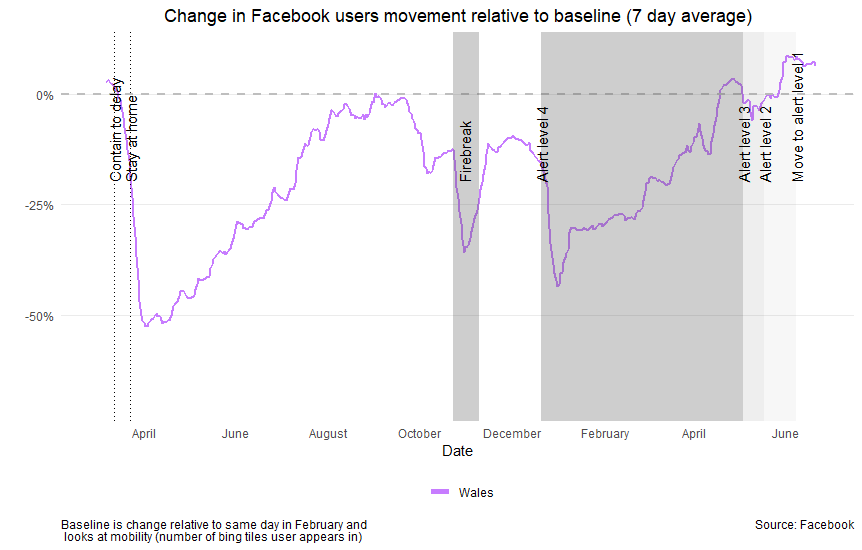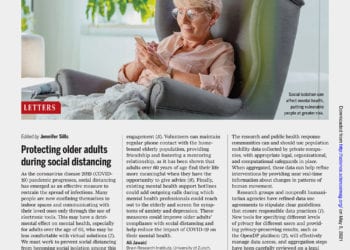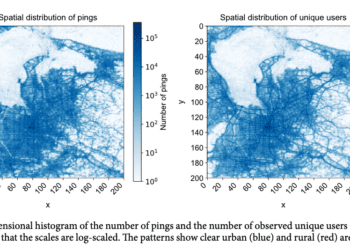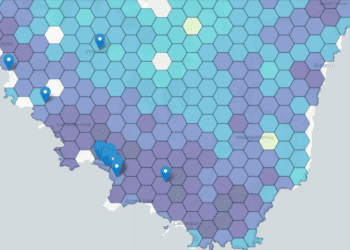Wales is home to more than three million people, a country within the United Kingdom with its own government and set of administrative bodies responsible for responding to COVID19.
When the UK was approaching the first lockdown order, the Welsh Government’s Data Science team didn’t know how exactly they would measure the public response in Wales. They had thought about possible ways of accessing data such as traffic flows, but they soon became aware of Facebook’s Movement Range Maps, which had been purpose built for measuring the rate at which populations were generally staying home or whether or not they were still traveling a great deal. Upon first glance of the data, they noticed that the data were available at a subnational level, allowing for sufficient granularity to track population changes in moderately sized geographies, while still being sufficiently aggregated to measure policy-relevant changes in movement and protect privacy.
Following the first UK lockdown on March 23, the Welsh Government’s Data Science Team, led by John Morris, was able to detect the drop in mobility in people in Wales, in response to lockdown orders using Facebook insights, which provided rapid feedback into how people were responding to new policies (known as non-pharmaceutical interventions or NPIs). This was the first signal the team received into how valuable this data could be, especially given that rises in mobility and people congregating are likely to precede actual COVID19 infections. As a result, tracking changes in mobility would allow public officials to understand the public response to local policies.

Over the coming months, Facebook Movement Range Map proved an indispensable tool for measuring changes in mobility stemming from shifts in non-pharmaceutical-interventions, as well as in changes in weather and holidays. The Welsh Government was able to detect increases in mobility when weather was warmer and milder, and over the summer, when restrictions were relaxed, the team observed an even higher increase in mobility. During September, as cases began to rise again, this led to the Welsh Government introducing local restrictions in response to rising numbers in local areas, and, in late October a 17-day circuit-breaker-type lockdown across the whole of Wales, which was known as the “fire break.”
During the “fire break”, Facebook mobility data proved incredibly helpful, as it was available on a daily basis for the day prior, allowing the Data Science team to tell within 48 hours if the additional restrictions had resulted in significant reductions in movement and increases in people staying at home. Furthermore, incremental shifts in NPIs could also be tracked. For example, during the “fire break,” non-essential businesses and schools were closed, but during the second week, schools reopened, which caused a slight rise in mobility. Armed with these insights, the team could determine how much school re-openings affected mobility and the impact these adjustments were likely to have in the future.
In December, when the Welsh Government enhanced restrictions on hospitality businesses, including early closures of bars and restaurants, restriction of alcohol sales and the closure of indoor venues, large drops in mobility again reflected public adherence to the new measures. In addition, to measuring the effectiveness of NPIs, the Data Science team was able to use Movement Range Maps to compare and contrast the effectiveness of different types of restrictions.
The “fire break” in October decreased mobility by a far greater rate than the December coronavirus restrictions (before the full lockdown was introduced just before Christmas), which allowed the team to anticipate how future interventions were likely to be adopted in the population based on their unique characteristics.
Throughout the course of the pandemic, the Welsh Government’s scientific advisers – the Technical Advisory Cell – have published weekly reports using Facebook mobility data and other sources to provide the latest scientific information for the pandemic. They have also discussed potential caveats in mobility data, but continued to leverage it as an indispensable monitoring tool throughout the course of the pandemic.



